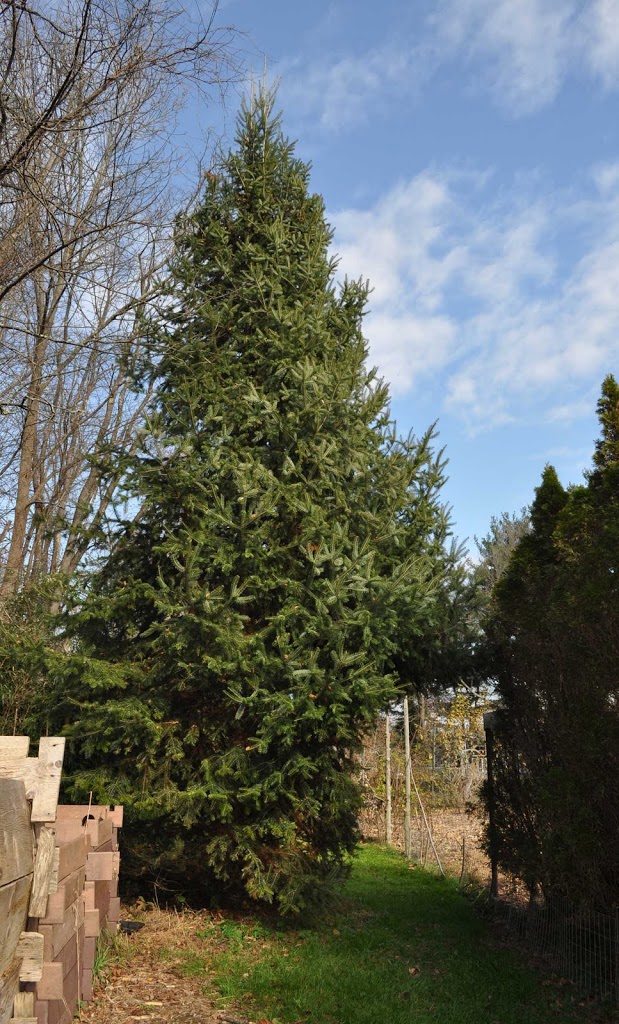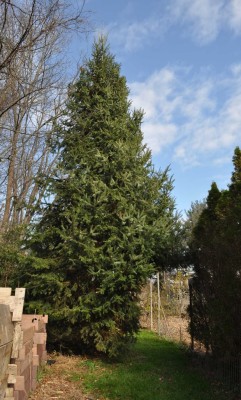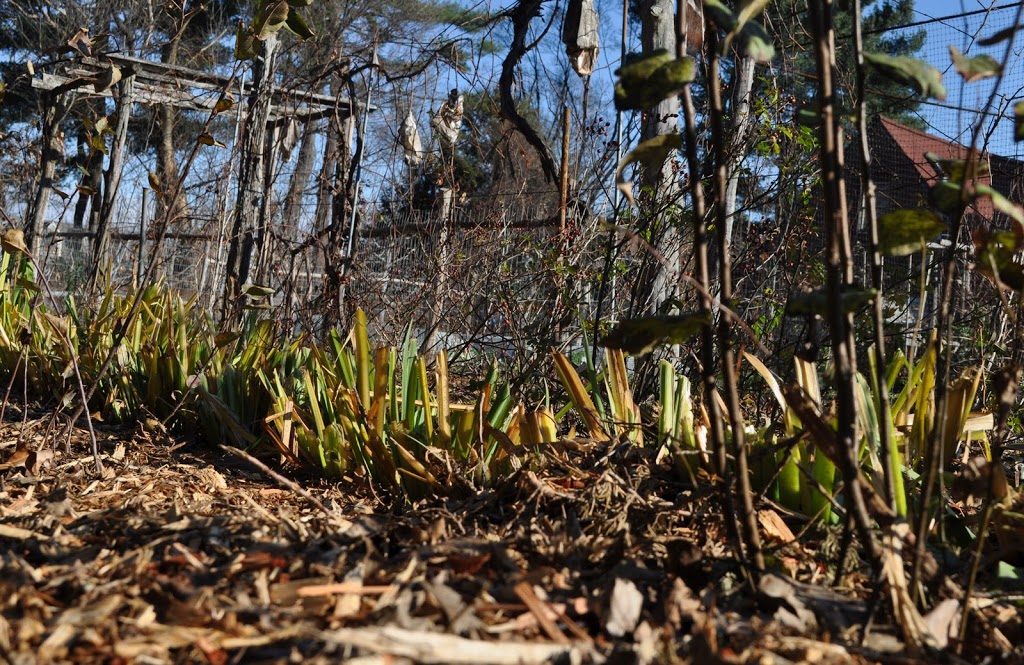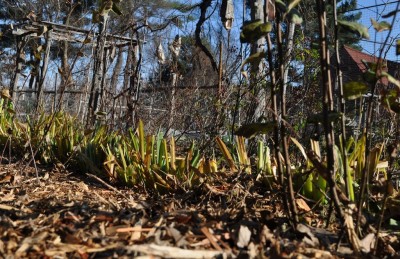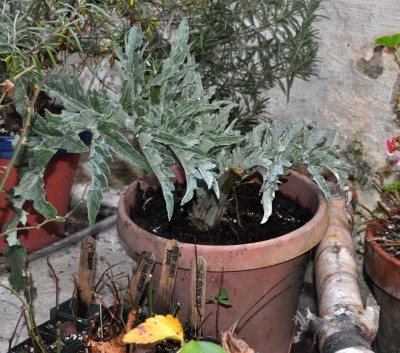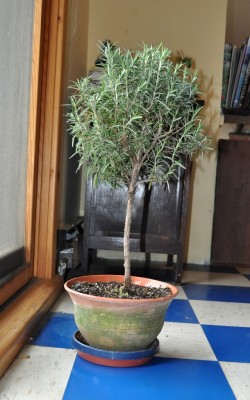XMAS TREE PLANTATION ON MINI-PLOT
/1 Comment/in Gardening, Planning/by Lee A. ReichA living Christmas tree seems the “right” thing to do: You get a holiday tree decorating your living room for a couple weeks; the planet gets a tree to soak up carbon dioxide, provide a playground for wildlife, and contribute to the landscape greenery. The problem is that yearly planting out of living Christmas trees in most yards pretty soon leads to a small-scale version of the Black Forest. A lugubrious and mysterious landscape is not for everyone.
But there is a way to enjoy living Christmas trees, and keep the scene sunny and winsome: Plant very young trees, then harvest them when they reach the size to cut for Christmas. Essentially, have your own tree farm. The tree lives — and you enjoy it as such — until you cut it.
You may imagine that a tree farm big enough to supply you with one tree a year would take up too much space. Not so. A Christmas tree needs about eight years to grow to a harvestable size of about six feet tall. If you have enough space for eight trees, you can cut one and plant a new one every year, for an endless supply. At five foot spacing, all you need is about 200 square feet of area — perhaps a forty foot row, perhaps a rectangular plot ten by twenty feet. This spacing gives each plant enough sun to grow into a well-shaped tree, and allows you plenty of room to mow around each tree. If you prefer smaller Christmas trees, you can plant even closer.
Your tree farm need not be in an out-of-the-way place. A row of trees might make a nice, evergreen hedge. With the wide spacing and variation in tree sizes, the hedge will be somewhat informal. But at least you do not have to worry about the hedge becoming too tall, because trees get removed as soon as they are about head height. The trees also might make a nice screen for your compost bin or dog’s house. How about a miniature forest for your child?
Growing your own trees gives you the option of choosing whatever type of Christmas tree you want. Most commonly cut nowadays for Christmas trees is Scotch pine, a tree that is very cold-hardy, fast growing, and tolerant of many different soil types. And, the plant holds its needles very well indoors.
———————————————-
Scotch pine has been popular only since the 1930s, and over the years many other species have been in favor. In the middle of the 19th century, cedar was a favorite. But it dropped its needles too easily indoors. Then hemlock, one of the fastest growing evergreens, became popular. Its main defect is that its flexible branches bow too far to the ground under the weight of ornaments. Nowadays it’s also beset by a serious insect pest, the woolly adelgid. By the end of the 19th century, balsam fir became popular. This tree, still popular for Christmas in New England, makes up for its deficiencies — slow growth, less than ideal shape, and some needle drop — with its woodsy aroma that is rightly reminiscent of northern or mountaintop forests.
If you grow balsam fir — and I planted a half-dozen of them almost 20 years ago — make sure to give it a cool, moist soil. The climate around here is warmer than usually enjoyed by balsam fir, but I figured that the fragrance made balsam fir worth a try. My dog Stick, then a leashed puppy, soon chewed up 5 of my young trees, which were all that he could reach when he was young and leashed. One survived, and the survivor is now a towering, fragrant beauty about 25 feet tall and so wide that I had to cut an opening in its lower limbs to allow passage past it along the back portion of the garden.
I never could bring myself to cut that sole survivor to bring indoors for the holidays. The tree is so kind as to keep making two leading stems. Cutting one of them lets the other grow and gives me a manageable holiday tree that leaves the remaining tree healthier. If both leading stems were allowed to grow, they would be apt to split apart at their origin.
———————————————————–
Nowadays, besides Scotch pine, other popular Christmas trees include eastern white pine, Norway spruce, white and Colorado spruces, Douglas fir, and Fraser fir. White pine is fast growing, with an open form that you may or may not prefer in a Christmas tree. This native plant tolerates almost any soil, and even a bit of shade. Norway spruce is almost as fast growing, and is a graceful tree with arching limbs along the bottoms of which dangle short, needled branchlets. Norway spruce needs well-drained soil and full sun.
White and Colorado spruce, and Douglas and Fraser firs, are slow-growing trees. (The two firs are unrelated: Douglas is Pseudotsuga menziesii; Fraser is Abies fraserii.) The two spruces require moist, yet well-drained soil, in full sun. Douglas fir needs full sunlight, but cannot tolerate a windy site or dry soil. Douglas fir holds its needles indoors almost as well as does Scotch pine. Fraser fir needs wet soils in full sun or part shade.
A miniature tree farm requires very little time for maintenance. A thick mulch of straw or leaves will conserve soil moisture and smother weeds. Grow grass between the trees and mow it regularly to prevent competition for nutrients and moisture, especially when the trees are very small. If you prefer a tighter growth habit to your trees, and have the time and inclination, prune them once a year, shortening by half the “candles” of new growth before they expand in early summer. And finally, keep teething, playful puppies at bay from any trees for their first couple of years.
Thanks(soil)giving, Chokes, & Rosemary
/6 Comments/in Gardening/by Lee A. ReichAs part of my Thanksgiving celebration, I’m thanking the soil. Soil, after all, is where it all starts. We’re thankful for the plants, but the plants got where they got because of the soil, offering plants support, water, air (which roots need), a friendly microbial environment, and nourishment.
Basically, I thank the soil with organic materials, that is, stuff that is or was living. Stuff like wood chips (dead), straw (dead), compost (living and dead), manure (living and dead), and autumn leaves (dead). Organic materials are what put the “organic” in organic gardening and farming. Organic materials are bulky, and are what chemical fertilizers have too often replaced. Compost, for instance, is about one percent nitrogen, so to supply the average 2 pounds per 1000 square feet of actual nitrogen needed would require 200 pounds of compost. Opt for 10-10-10 chemical fertilizer and a mere 20 pounds per 1000 square feet would do the trick.
Oh, but that 180 pound difference between compost and 10-10-10 offers so much more than just nitrogen. Compost serves up a smorgasboard of nutrients reflecting the diversity of what went into the compost pile. Just about everything goes into mine, including orange peels from California, olive pits from Peru, even my old Levi’s in addition to garden and kitchen waste, hay, and manure.
That’s not all: Compost and, as they decompose, other organic materials, offer a witch’s brew of natural compounds that improve plant nutrition by unleashing nutrients from the soil’s rocky matrix and rendering nutrients already in the soil even more available to plants. As important, these organic materials help soils hold both water and air, and provide a congenial, nutritive environment for beneficial organisms that help plants fend off diseases and further abet plant growth. Whew! That’s a lot of goodness.
So I’m hauling cart after cart of organic materials. Vegetable beds get an inch depth of crumbly, dark, pleasantly fragrant compost from piles built last year. Paths in vegetable gardens get wood chips. I am mulching berry plantings with wood chips or leaves, according to what’s available and my whims. Leaves that drop from the chestnut trees will be supplemented with leaves that neighbors with leafier yards need to discard. Other trees get wood chips. Fruit trees get rotted leaves, which are very similar in composition to compost in addition to wood chips and, possibly, horse manure with wood shavings.
I hope to finish soil Thanksgiving before the first snow that stays.
————————————————————-
My gut reaction is to shy away from eating any plant with “choke” in its name. Chokecherries (Prunus virginiana) are not for me. I did once grow chokeberry (Aronia spp.), which lived up to its name; the plant is long gone. Chokeberry is said to make a tasty jam or juice, which I realized, anything can if given enough sweetener, dilution, and addition of other flavors.
Artichoke is one “choke” worth growing; its “choke” comes not from the throat but from the Arab name for the plant, al-qarshuf. The problem is that artichoke is one choke that isn’t very happy here. It needs mild winters and summers not searing, which are conditions you might find right along the coast in California or the Mediterranean. So, of course, I am growing it here in New York’s Hudson Valley.
I grew artichoke years ago and did harvest a few small buds; this year I was hoping for at least larger buds. Imperial Star is the variety recommended for northern gardens because it forms buds the first year so can be grown as an annual. Not mine. I sowed seeds early this spring after giving this perennial the cold treatment necessary to fool it into thinking it’s gone through a mild winter and can begin flowering. Imperial Star is more easily fooled than other varieties. Plants given to a friend did make a few small buds but my plants just grew. (Northern Star is another, newer possibility for northern gardens because it allegedly survives winter temperatures below zero degrees F.)
No need to throw in the towel in growing artichokes, though. Among my last activities in the vegetable garden is to dig up one artichoke plant, pot it up, and overwinter it in a bright window in my cool basement. I’ll give it a head start in the greenhouse in spring, then plant it outdoors again when the the weather warms. If the harvest is nonexistent or unreasonably small, I’ll abandon artichoke growing for another 15 years.
————————————————————–
Increasingly, my attention is turning indoors. It has to, with all the thirsty plants now sitting in sunny windows. One of the thirstiest, oddly enough, is rosemary. Too many rosemary plants towards the end of too many winters have surprised me by all of a sudden, when brushed against, shedding leaves, dried and dead, as were the plants.
As a Mediterranean plant, you’d assume it likes dryish condition. It does like its head dry, at least in summer. Stiff leaves make it hard to tell when rosemary is thirsty. They don’t wilt, they just dry up and die.
So now I err on the side of too much rather than too little water. With extra perlite, my potting mix is well-drained, making too much water hardly a problem as long as the saucer beneath the plant isn’t filling with water. The best way to tell whether or not a rosemary plant is thirsty is to feel the weight of the pot.
Except for one rosemary plant conveniently growing in the kitchen, the others are spending winter in the basement, along with the artichoke.
UNCOMMON FRUIT, COMMON FRUIT, CATERPILLAR HEDGE
/2 Comments/in Gardening/by Lee A. ReichWith the economy the way it is, forget about any hedges against inflation. Anyway, I’m more concerned about hedges against poor harvests, and that hedge is to grow a diversity fruits and vegetables. I’ve never had a year of poor harvests of everything. Cabbage and broccoli will revel in a cool summer during which peppers or melons hardly ripen. Bean beetles that might ravage green beans won’t touch tomatoes, okra, and other vegetables; they won’t even nibble soybeans.
Besides offering a hedge, that diversity also usually presents me with a spectrum of flavors and nutrition.
In fruits, 2011 was a particularly good year for pears and hardy and super-hardy kiwifruit. These kiwifruis are grape-sized, smooth-skinned cousins to the fuzzy kiwifruit of our markets. The flavor is similar, but better, and you pop the whole fruit into your mouth, skin and all. The plants are strong-growing vines, so pretty that they were for decades planted strictly as ornamentals, their gustatory treasures lying hidden behind leaves and ignored. In contrast to fuzzy kiwifruits, hardy and super-hardy kiwifruits can be grown just about everywhere.
Super-hardy kiwifruits, Actinidia kolomikta (“super-hardy” because they tolerate cold to minus 40°), ripened back in early August and hardy kiwifruit, A. arguta (hardy to minus 25°F.), started ripening in mid September. You know these fruits are ripe for picking when the first berries just begin to soften.
I harvested all my hardy kiwifruits once the first ones ripened. Some were firm and some were ready to eat. Kept under refrigeration, the firm ones slowly ripen; at room temperature, they ripen faster. Ripened berries have been, and will be, for a few more weeks, a colorful, sweet-tart, flavorful addition to morning cereal.
———————————-
Apple trees have never borne well here. The reason is because I am trying to grow them “organically.” That means giving special care to the soil, keeping it nourished with compost, leaf mold, wood chips, and seaweed. That means maintaining a diversity of flowering plants to attract beneficial insects. And it means minimum or no spraying of pesticides which, if needed have minimum impact on everything but the target pest(s).
Admittedly, my farmden is not ideal for apple growing. Six-thousand acres of woods (not mine, Mohonk’s), overwintering home to many pests, lie within 50 feet of my trees. And cold air settles into this floodplain of the Wallkill River, so morning fogs and dews linger longer than on higher ground to fester disease problems. So I do spray my trees, many times each season, with Surround (a commercial formulation of kaolin clay) and sulfur (a naturally mined mineral).
The apple trees looked so hopeful in the spring. No late frosts. Exuberant, new growth. Pea-sized fruitlets rapidly swelling to marble-size, then golfball-size, and larger.
But something, some things, happened between those halcyon days of June and harvest. Fruits disappeared, dropped, became ugly with blotches and dimples. My farmden isn’t the only one to suffer such affronts. Basically, if you wanted to pick the hardest fruit to grow in eastern U.S., what fruit would that be? Apple! Why? Because of a very few, but very serious insect and disease problems. Plum curculio, codling moth, apple maggot, apple scab, fire blight, cedar-apple rust, and powdery mildew are the culprits.)
Still, I haven’t thrown in the towel yet with apples. I noted this year that more attention is needed to late summer diseases, such as black rot and bitter rot. And the apples I do harvest might be few, but their flavors are supreme, in large part because of variety selection and perhaps due to terroir.
Apples are not the only fruit worth growing around here. Even if the apple crop is poor, this year I had and have plenty of, in addition to pears and kiwifruits, medlars, raspberries, and grapes. And every year seems to be a good one for pawpaws, persimmons, and blueberries. I’ll be digging into the 40 quarts of blueberries in the freezer just as soon as the last of the kiwifruits are finished.
——————————-
And speaking of hedges, green ones, my yew caterpillar is going into winter looking better than ever. This hedge started out as 4 boring yew bushes planted about 25 years ago and needing multiple prunings each growing season to prevent their overwhelming nearby windows, or even the whole house.
Inspired by Keith Buesing’s (of Gardiner, NY) fabulous green sculptures, a couple of years ago I began re-forming the yews. Yew is an adaptable plant, amenable to pretty much all manners of pruning, and the reformation is now pretty much complete. (The smiling mouth is still under construction.)
Multiple prunings are still needed each growing season, but they are mostly light cuts to polish and maintain the form.

